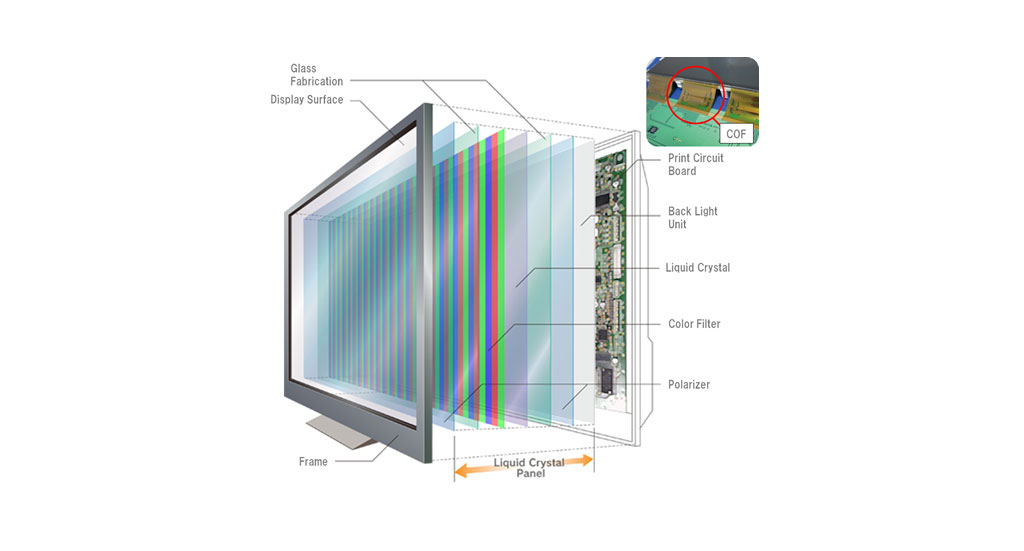Introduction to LCD Displays
LCD technology is relatively simple: LCD screens consist of a substance that remains in a liquid state but possesses certain properties characteristic of crystalline materials. LCD displays are passive devices that don’t emit light to produce text, images, videos, or animations. Instead, they modify the light passing through them. The way in which the light is altered as it passes through the internal structure of an LCD is what enables the display to generate text, images, and other visual content.
An Overview of the History
In 1970, the first functional liquid crystal display was invented by J. Fergason, an American inventor. Prior to this invention, such devices consumed too much energy, had limited operating life, and produced images with poor contrast. A new LCD monitor was introduced in 1971. While liquid crystals had been discovered much earlier, they were initially used for different purposes. When subjected to an electric field, the molecules of liquid crystals can alter their orientation, which in turn modifies the properties of the light passing through them. Through further research, a connection was established between increasing electric voltage and the change in orientation of crystal molecules, which enabled the creation of images. Initially, liquid crystals were used in displays for calculators and quartz watches, and later they were utilized in monitors. Today, advancements in LCD technology have made such screens extremely popular in desktop computers and a variety of other devices.
LCD display technology
- LCD screens consist of an array of small segments called pixels that can be manipulated for displaying information.
- LCD displays are composed of several layers, including two substrate panels made of glass material that are free of sodium and play a crucial role in the display.
- The substrate contains a thin layer of liquid crystals between them, and the panels have flutes that direct the crystals and give them a distinctive orientation.
- The flutes on each panel are parallel, but they are perpendicular between the two panels. Longitudinal flutes are obtained by placing thin films of transparent plastic on the glass surface and then processing them in a particular way.
- In contact with the flutes, the molecules are oriented identically in all the cells.
- The liquid crystal panel is illuminated by a light source, depending on where it is located, as the LCD panels operate on reflection or light transmission.
- The plane of polarization of the light beam is rotated by 90° as one panel passes. When an electric field appears, the molecules are partially aligned along it, and the angle of rotation of the plane of polarization of light becomes different from 90°.
- LCD monitors use the backlight of the monitor to output a colour image so that light is generated at the back of the LCD monitors.
- To obtain a picture with good quality, even if it is dark, colour is obtained using three filters, which distinguish three principal components from the radiation of a white light source.
- By combining the three primary colours for each pixel of the screen, any colour can be reproduced.Top of Form
A Comparison of LCD Technology: Past and Present
LCD screens, also known as flat panels, dual scan active matrix, and thin-film transistors, have gained immense popularity due to their sleek design, compactness, and efficiency. Modern LCD monitors offer high-quality contrast and clear, bright images. However, in the past, liquid crystal technology was slower and less efficient with lower contrast levels. The first matrix technologies, called passive matrices, were suitable for textual information but produced “ghosting” on the screen with sudden picture changes. In comparison, LCD technology orients each pixel separately, providing higher clarity for displayed text compared to CRT monitors, which previously competed with LCD screens. Over time, advancements in technology have led to liquid crystal monitors surpassing CRT monitors and occupying a leading position among displays used for various applications. LCD monitors are now widely used not only in desktop computers but also in TVs, photo and video cameras, laptops, tablets, smartphones, car navigators, e-books, MP3 players, watches, and more.
Wrapping it up!
In conclusion, LCD technology has come a long way since its inception in the early 1970s. Modern LCD screens are now widely used in various electronic devices, and their popularity continues to grow due to their slim design, efficiency, and superior image quality. As a prime manufacturer and supplier of LCD monitors, Royal Display offers a wide range of options for customers, ensuring they have access to the latest technology. With continued advancements in the field of liquid crystal technology, it’s clear that LCD monitors will continue to play a significant role in the world of electronic displays, and Royal Display is poised to remain at the forefront of this industry.






